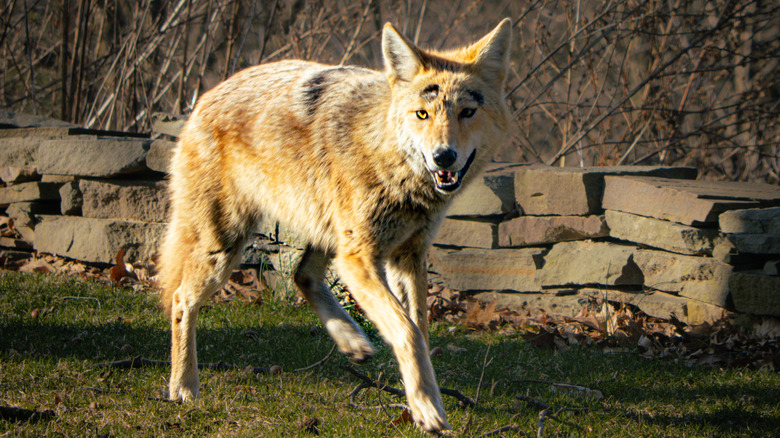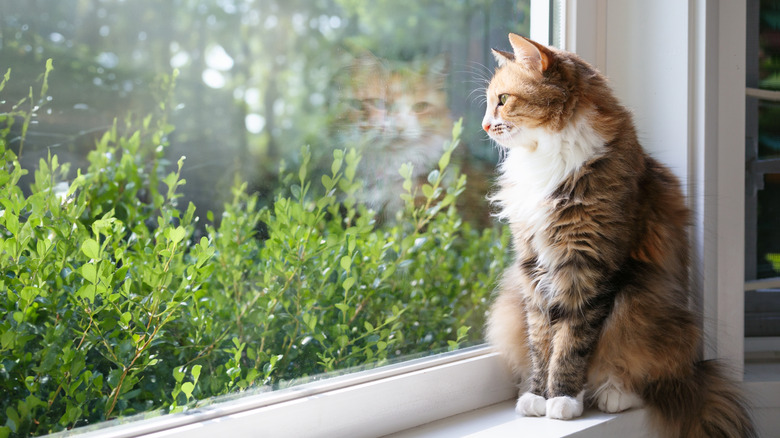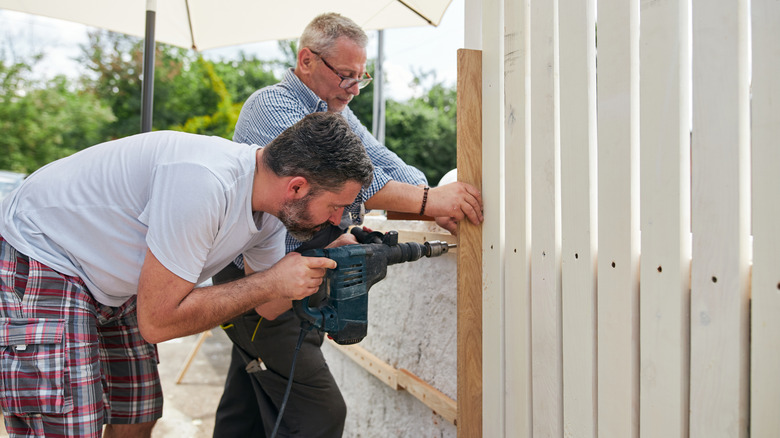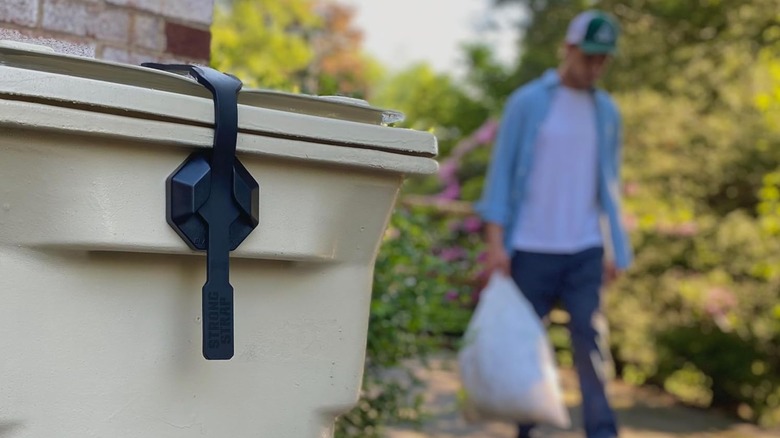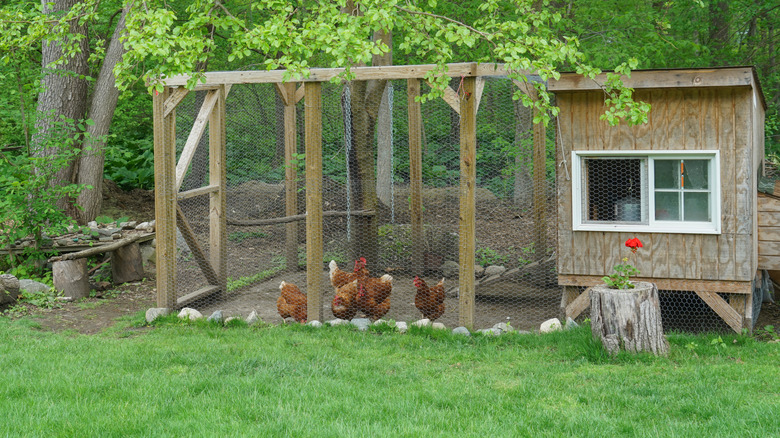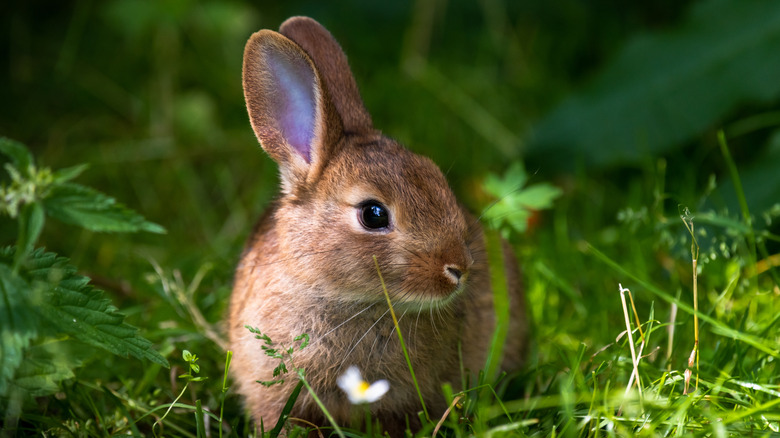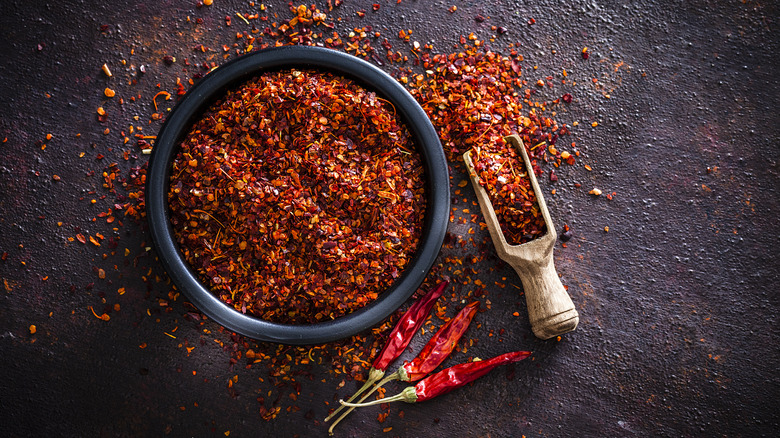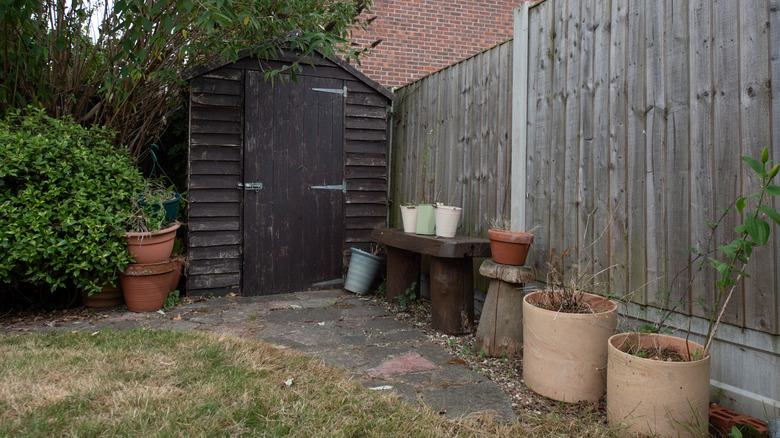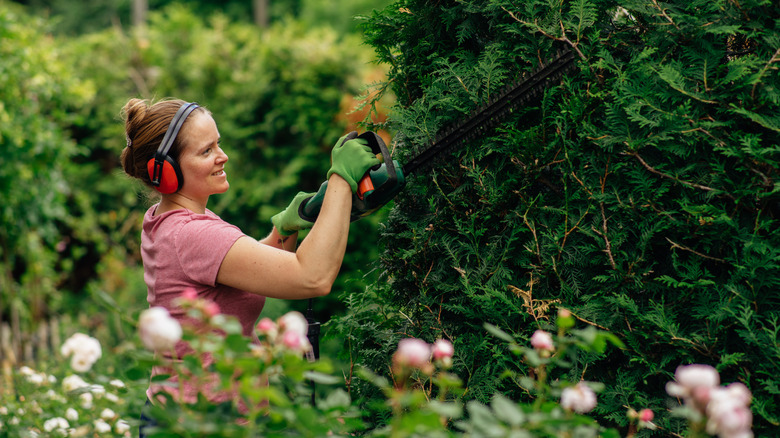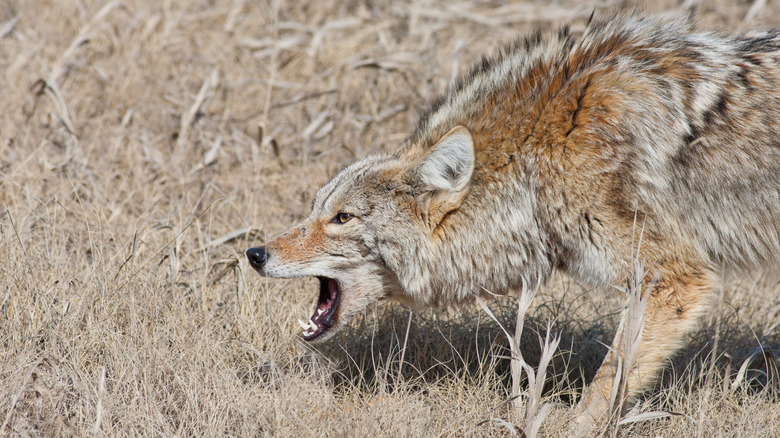Tips And Tricks To Keep Coyotes Out Of Your Backyard
We may receive a commission on purchases made from links.
While coyotes rarely attack humans, seeing them in your backyard can be concerning. Beyond the potential that they could attack you or another member of your household, they can pose a more serious threat to any pets or livestock you may have. Because of this, it is important to take measures to discourage them from visiting your property. If they get too comfortable in your yard, they will visit more frequently and may even show up during the daytime instead of at night.
If you want to keep coyotes from returning to your yard or discourage them from visiting in the first place, there are several things you can do. Before we get into the strategies you can try, it is important to note that keeping coyotes away can be challenging. They are often resistant to our efforts to scare them away and may become habituated if the same tactic is used repeatedly. For that reason, you'll likely need to combine several of the ideas below — and continue being persistent — to keep them out of your yard.
Only feed pets indoors
If you feed your cat or dog (or other animal friends) outside, you may inadvertently attract coyotes into your yard. The smell of the food may encourage them to come and seek their next meal. The best option is to switch to feeding your pets indoors. This way, there won't be extra food left outside to draw them to your property.
If feeding your pets indoors isn't possible for some reason, then you must avoid leaving the dishes outside after your animals have eaten. Even if there are no pieces of kibble left behind, the scent of the food will still be all over the bowl, potentially welcoming the coyotes to your space. Similarly, you should avoid storing pet food outdoors to make sure it doesn't attract these wild animals. If that's not feasible, consider keeping your furry friends' meals in a durable, tightly sealed container.
Keep pets indoors or closely supervise them
In addition to happily munching on pet food, coyotes can also prey on the animals. This is more likely to happen after they have been in the neighborhood for a while and have successfully found reliable food sources. As they become less fearful, they may turn to pets, particularly cats and smaller dogs. Their attacks on these animals can range from injuries to fatalities.
If you live in a coyote-prone neighborhood, it is safest to always keep cats indoors. You may want to supervise dogs even if they are running around in a fenced yard. When walking your dog, always use a leash, or else they will be a much easier target for a coyote. There won't be much you can do to stop an attack on an unleashed dog. While supervising your dogs is important all year, it is even more essential between January and April. These months are the breeding season for coyotes, and the males are typically more aggressive during this time.
Install a fence or modify existing fencing to make it more difficult for coyotes to scale
Constructing a 100% coyote-proof fence might be impossible in most residential settings. However, you can add a fence to your yard to make it more challenging for the coyotes to enter. With such a challenge, they may decide they're better off elsewhere and might cease trespassing in your yard. Fences should be a minimum of 5 ½ to 6 feet tall to discourage coyotes from invading your space.
Technically, a determined coyote could scale a 6-foot fence with relative ease. However, you can make this task more difficult by adding a fence extension, coyote roller, or barbed wire to the top of the fence. Angle these extensions toward the outside of your yard. Another way you can improve an existing fence is to build an apron about 18 inches beneath the ground. This will discourage coyotes from digging under the fence and gaining access to your yard. It is also important to consider the fence material, as some will be easier for coyotes to scale than others. Consider a smooth metal, vinyl, or PVC, and avoid common fence installation mistakes.
While fencing can deter coyotes from entering your yard, you shouldn't rely solely on it. Coyotes are adaptable and can come up with solutions to overcome barriers. Use fencing with other measures, like motion-activated lights and sprinklers, for the best results.
Coyote-proof your trash cans
While coyotes don't typically scavenge through trash cans, it is still best not to tempt them. If you have leftover scraps of food in your trash, they may decide to rifle through it for their next meal. Purchasing a wildlife-proof trash can or modifying your existing one with a locking strap, like this one from Blazer, will deny the coyotes access to your waste.
Even with a secure trash can, keep your outdoor surroundings clean and exercise caution. Don't bring your trash outside until the morning of your scheduled pickup. This will limit the time the odors from the meats and other food scraps could potentially draw the coyotes to your yard. Consider encouraging your neighbors to hold off on bringing their garbage to the curb and to use a locked trash can to lower the chances of coyotes frolicking in the neighborhood for food.
Keep livestock secure
If you live on a farm — or even have a backyard chicken coop — it is imperative that you take measures to protect your animals. In addition to killing your livestock, coyotes will also learn that your home is a good source of food. They will be more likely to return, continuing to threaten livestock, pets, or even people if they get too comfortable.
There are a few things you can do to protect livestock against coyotes. First, consider building a fence — using the above recommendations regarding fence height, apron depth, and angled fence extensions at the top — to deter coyotes from entering the space where you keep your livestock. Avoid leaving the animals out overnight when coyotes are likely to be most active. The most secure place for each animal is a pen or a cage with a top cover. Furthermore, ensure their home is well-lit. If possible, use motion-sensor lights, which will likely scare coyotes away upon activation.
Discourage rodents from nesting on your property
While rabbits can destroy your garden, the same can be said for rodents and other small wildlife. However, undoing your hard work is not the only harm these animals can do. Their presence may attract coyotes to your property. Rabbits, mice, and birds comprise a large portion of a coyote's diet. So, if these critters are plentiful in your yard, it is only logical to conclude that coyotes will try to gain access to hunt them. Discouraging these animals from nesting in your yard can help decrease their populations and make the space less appealing to coyotes.
Rodents are always looking for a food source, so be mindful of what your garden offers them. Consider securing the plants that these pests like. While it can be nice to welcome birds to your yard with a bird feeder, you may want to put it away for a short season. Bird seeds that fall to the ground can attract rodents. Plus, coyotes will also happily eat birds (and their food), so you may inadvertently be making your problem even worse.
Scare coyotes away with loud sounds
Hazing is one of the strategies experts recommend for scaring coyotes away from your property. One hazing method involves using loud sounds to startle and scare them off. We recommend yelling at the coyotes. As you do so, making yourself appear larger by waving your hands or opening your jacket outwards can make your efforts more effective.
You can also blast an air horn (such as the air horn can from Better Boat) or blow a whistle (see emergency whistles from LuxoGear) to frighten them. Clanging two pans or shaking a coffee can filled with coins, marbles, or other metallic items is also a good idea. Depending on the coyote's initial reaction, you may need to persist in your efforts.
While hazing can be effective initially, it may not keep the coyotes away for good. These techniques are most likely effective with coyotes who are new around humans or timid. Over time, they can learn to adapt to loud noises and no longer be deterred by them. For this reason, you shouldn't rely on hazing alone to keep coyotes away from your property; instead, combine it with other deterring efforts we have discussed. Check out more things to do when you encounter a coyote.
Use a light-based deterrent system to keep coyotes away
Another hazing technique involves using lights to deter coyotes from visiting your yard. This technique will be most effective at night when bright or flashing lights are more noticeable and "scary" to the creatures. Consider installing motion-sensing flood lights, like the LEPOWER LED Motion Sensor Flood Light, which will automatically activate when the coyotes move around in your space.
Another option is to set up strobe lighting in your backyard; the ENUOLI Mini LED Strobe Light is effective. If it is the holiday season — or you're OK with leaving decorations up year round — you can also try setting strands of Christmas lights, like the TW SHINE Christmas Lights, to blink or flash.
Again, it is important to remember that coyotes are very adaptable. While bright or flashing lights may initially ward them off from your yard, they may learn that these lights do not pose any real threat to them after some time. If temptation is on your property — such as livestock or rodents — their desire for a meal may override their fear.
Try a scent-based repellent to keep coyotes from entering your yard
Scent-based repellents can also be implemented as one component of your coyote deterrence plan. However, it is important to note that these products may not always be effective. If they keep the coyotes away, their potency isn't long-lasting, so you shouldn't rely on this technique alone. Still, there are a few scents that coyotes dislike that you can employ.
One solution is to use white vinegar to deter coyotes. The animals do not enjoy the strong and unpleasant scent of vinegar, so leaving several open bowls around your property may help. You'll want to regularly refill them as the product evaporates or spills. Sprinkling cayenne pepper on your lawn or using full cayenne peppers with onions can also help. Coyotes, as well as many wild animals, find peppers repugnant due to their capsaicin content. Still, you'll need to reapply cayenne pepper to your lawn as its effectiveness wanes or is washed away during a rainstorm. Pro tip: Protect your skin from the burning sensation capsaicin causes by wearing gloves, such as the HANDLANDY work gloves.
Ammonia is another scent that coyotes do not like. Soaking some old towels in the liquid and placing them around your yard might help make the space seem less desirable to the animals. Just remember to take precautions when using ammonia. Exposure to high levels of the chemical can cause damage to your lungs if it is inhaled. Wear a mask when working with it, and protect your hands with gloves.
Make sure crawl spaces and potential denning areas are securely blocked
The coyotes roaming your neighborhood may be looking for the ideal spot to make a den to raise their pups. The last thing you want is for them to decide that your yard offers the ideal conditions to meet these needs. To ensure your home doesn't provide the perfect environment for coyotes, keep shed doors securely closed and block access to cellars or crawl spaces on the property.
Where needed, consider installing a fence around areas that coyotes might decide are den-worthy. Inspect the fencing regularly, as it is unlikely to fully deny them access to spaces where they may wish to go. Upon inspection, you might be able to identify where the coyotes gained access, allowing you to modify the design to limit their ability to penetrate it.
If a coyote has already set up a den in your yard, take extra precautions to protect yourself and any children or pets you have. These animals aggressively protect their young, so stay indoors and away from the area. Consider calling a professional service to have the coyotes safely removed.
Clear away areas of thick brush and other vegetation
Getting your overgrown yard under control can do more than just improve your home's curb appeal. It can keep your property from being as appealing to coyotes. The ideal hunting spot for a coyote provides a space where they can hide, enabling them to sneak up on their prey. So, if your yard has a lot of bushes or tall, thick grasses, coyotes will view it much more favorably than a wide open space with few places for them to take cover. Cut tall grass and weeds and prune your trees and shrubs. When cutting back the branches, you'll want to focus on the sections closer to the ground, as these will provide the greatest benefit to the coyotes.
If you have any fruit trees in your yard, you'll want to monitor their progress and harvest them once ripe. Avoid letting the fruit drop from the trees, as once it is on the ground, it will offer a greater incentive for the coyotes to enter your yard. Similarly, cover or fence in your compost pile so the decomposing food doesn't attract coyotes or the rodents they prey on.
Make sure you aren't inadvertently offering a water source for the coyotes
Like other animals, coyotes need more than just food to survive. They also require water. If your yard has a water source for the wild animals, barring them from your home will be more difficult. Assess your yard and eliminate the problem that may be attracting the coyotes. Some tips we've already shared can help you accomplish this goal. For example, you are more likely to have areas of standing water in an overgrown yard than in a better-maintained one. Fruits that have dropped from trees have a high water content, which is another reason you'll want to pick them before they drop to the ground.
You'll also want to get rid of some other seemingly harmless water sources in your yard. If you have a bird bath or fountain, consider emptying it, at least, until the coyotes have been gone for some time. Similarly, draining a backyard pond can also help deny the wild animals the water they are searching for.
Report aggressive coyotes to the authorities
The tips above can help you manage a coyote problem on your own, especially when you implement several different strategies together. However, they may not completely prevent the animals from coming into your yard. If coyotes get too comfortable in your yard (or the community as a whole) and are finding the food sources they need, they may become habituated. This means they will not be as fearful of humans and may start acting more aggressively toward children, adults, and pets.
Aggressive coyotes should be reported to local authorities immediately. They pose an increased risk to humans and animals and will likely need to be appropriately removed from the population. Some aggressive behaviors that warrant contacting the authorities include lunging at people or pets, growling or barking near your home, or stalking. Aggressive behaviors could also be indicative of rabies, increasing the risk of serious harm to anyone these animals attack.
